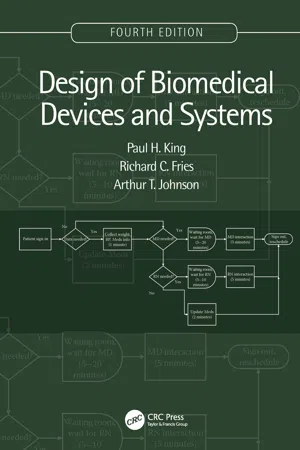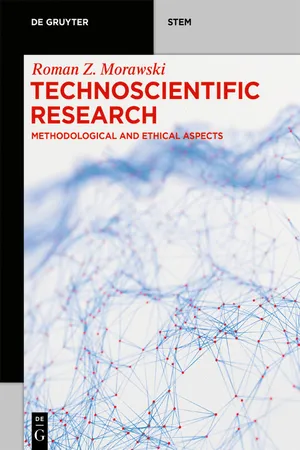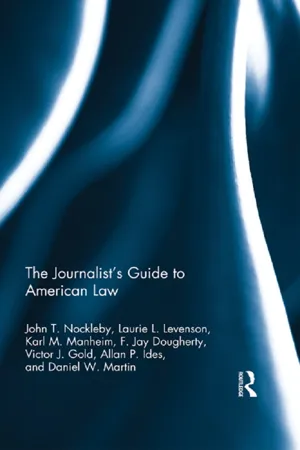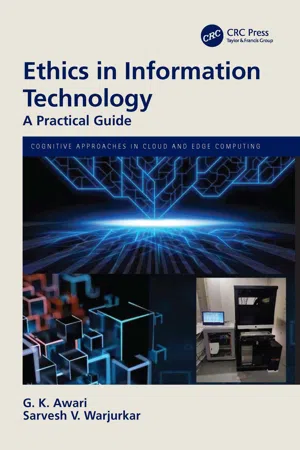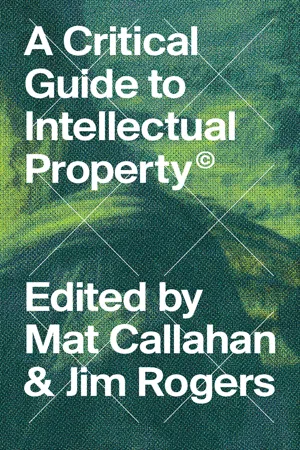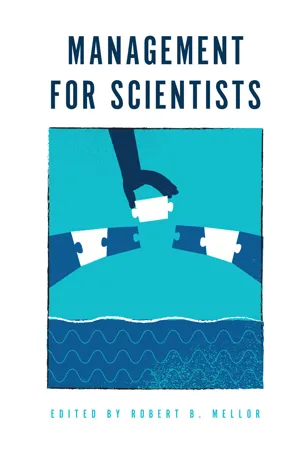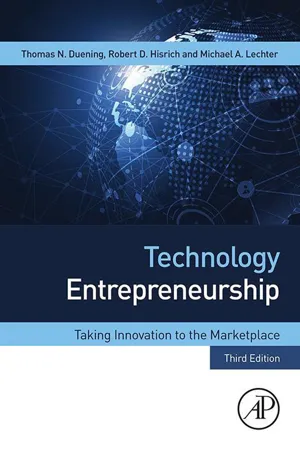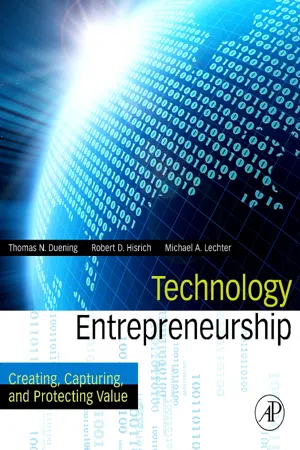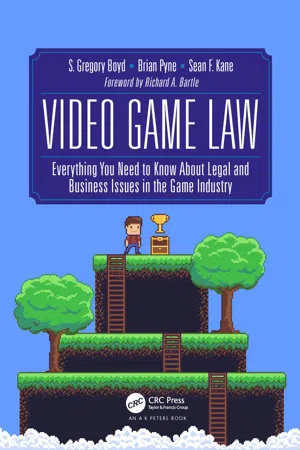Technology & Engineering
Intellectual Property
Intellectual property refers to creations of the mind, such as inventions, literary and artistic works, designs, symbols, names, and images used in commerce. In the context of technology and engineering, intellectual property includes patents for new inventions, trademarks for product branding, and copyrights for software code and designs. These legal protections help creators and innovators safeguard their ideas and investments.
Written by Perlego with AI-assistance
Related key terms
12 Key excerpts on "Intellectual Property"
- Paul H. King, Richard C. Fries, Arthur T. Johnson(Authors)
- 2018(Publication Date)
- CRC Press(Publisher)
Intellectual Property Patents, Copyrights, Trade Secrets, and LicensingUltimately property rights and personal rights are the same thing. Calvin Coolidge The march of invention has clothed mankind with powers of which a century ago the boldest imagination could not have dreamt. Henry GeorgeIntellectual Property (IP) is a generic term used to describe the products of the human intellect that have economic value. IP is “property” because a body of laws has been created over the past 200 years that gives owners of such works legal rights similar in some respects to those given to owners of real estate or tangible personal property. IP may be owned, bought, leased (licensed), and sold the same way as other types of property.There are four separate bodies of law that may be used to protect IP. These are patent law, copyright law, trademark law, and trade secret law. Each of these bodies of law may be used to protect different aspects of IP, although there is a great deal of overlap among them.20.1 PATENTS
A patent is an official document, issued by the U.S. government or another government, which describes an invention and confers on the inventors a monopoly over the disposition of the invention. The monopoly allows the patent owner to go to court to stop others from making, selling, or importing the invention without the patent owner’s permission. This amounts to a “fence around the property,” the property being the patent itself.Generally, an invention is any device or process that is based on an original idea conceived by one or more inventors and is useful in getting something done or solving a problem. An invention may also be a nonfunctional unique design or a plant. But when the word “invention” is used out in the technical world, it frequently implies a “utility patent” which means a composition, device, or process. In order for an invention to be patentable, it must meet three criteria: novelty, nonobviousness, and usefulness. Many inventions, while extremely clever, do not qualify for patents, primarily because they are not considered to be sufficiently innovative in light of previous developments. The fact that an invention is not patentable does not necessarily mean that it has no value for its owner.- No longer available |Learn more
Technoscientific Research
Methodological and Ethical Aspects
- Roman Z. Morawski(Author)
- 2019(Publication Date)
- De Gruyter(Publisher)
833 . The products of intellectual creation are object of IP regardless of the proportion between heuristic and algorithmic components they contain; this proportion has, however, an impact on the scope and nature of legal protection they may be eligible for.The idea of legal protection of IP finds a philosophical justification in the theories referring to:- – a utilitarian conviction that society should stimulate creative activity of its members by introducing appropriate material incentives834 ;
- – the belief, implied by the John Locke’s understanding of the law of nature, that any creator should have the exclusive right to the fruits of his work, as long as this right does not infringe upon the common social interest835 ;
- – the views expressed by Georg W. F. Hegel and Immanuel Kant, according to which any piece of work is an externalisation of individual personality of its creator; so, legal protection of this piece of work favours the development of his personality836 ;
- – the views, expressed, i.a., by Thomas Jefferson (1743–1826) and “young” Karl Marx, according to which legal protection of creativity fosters the formation of just society and the development of culture837 ;
- – the theory of justice, proposed by John B. Rawls, according to which information is a primary good, and the legal protection of IP contributes to its fair distribution838
- eBook - ePub
- John Nockleby, John T. Nockleby(Authors)
- 2013(Publication Date)
- Routledge(Publisher)
7Intellectual PropertyF. Jay DoughertyProfessor of Law (Copyright Law and Trademark Law), Loyola Law SchoolKarl M. ManheimProfessor of Law (Patent Law), Loyola Law SchoolThe term Intellectual Property is a relatively modern phrase, usually referring to several rather different bodies of law, namely, copyright, trademark, and patent law. Various other related business torts, such as trade secret law or unfair competition, might also be considered within this rubric. However, this chapter will focus on the three areas of law at the core of what we call Intellectual Property—copyright, trademark, and patent law.Copyright provides a set of exclusive rights in original works of expressive authorship. Patents also provide exclusive rights for new and useful products and processes. Trademark law applies primarily to distinctive words, symbols, and other devices that indicate the source of goods or services, and protects them from use by competitors of confusingly similar marks. This chapter will consider each of those bodies of law in somewhat more detail.Normally, when one thinks of property, tangible objects come to mind, either real property (land) or personal property (other physical assets). By contrast, Intellectual Property deals with intangibles—creations of the mind. These are often considered forms of property because of the rules that protect ownership and use of the creations. As with ownership of real property, these rules provide a legal basis to exclude others from certain conduct or uses of the subject matter. Thus, it is not unusual for an injunction, that is, a court order to do something or to refrain from doing something, to be awarded where an infringement, or even merely a likely infringement, is found.It is not uncommon for nonexperts, including journalists, to confuse these different bodies of law. For example, one sees a news story about a legal dispute over the title of a film or the name of a pop band.1 - eBook - ePub
Deal Makers
How intelligent use of contracts can help you sell more and deliver better
- Tiffany Kemp(Author)
- 2013(Publication Date)
- Anoma Press(Publisher)
10
Intellectual Property rights are rights in our intellectual creations
Intellectual Property rights, or IPRs, are a class of assets being built, developed and protected by companies in industries as diverse as photography, publishing, software development, domestic cleaning products, materials science and pharmaceuticals.What is Intellectual Property?Intellectual Property is something that, while it may result in a tangible, physical form (such as a drawing), is the product of intellectual activity (such as an idea or invention) rather than physical. This somewhat unsatisfactory definition can be built upon by considering how such property is protected, and the body of law and commercial activity that has sprung up around the concept of ‘Intellectual Property rights’.Why do we care? It’s possible that you, in the context of your current role, might not. But if your company spends lots of money developing and fine-tuning its products, you can see that it would probably quite like to have some sort of long-term benefit from that expenditure. If anyone could just copy their developments and reproduce them at will, there would be little incentive for anyone to invest in inventing new stuff.This means that companies are starting to focus more and more on protecting their Intellectual Property – the US case of Apple v Samsung (which was decided in Apple’s favour at the time of writing this book, but is likely to go to appeal) shows just how seriously innovative businesses take the subject of IPR, and the lengths they’ll go to protect it.Different classes of IPRs are ‘protectable’ by law
Originally conceived to encourage people and companies to invest time and money in creating new and innovative things, Intellectual Property rights are ones that can be protected by the law. There are different categories of rights in Intellectual Property that can be protected by law, each of which is designed to protect different rights and works in a different way. - eBook - ePub
Ethics in Information Technology
A Practical Guide
- G. K. Awari, Sarvesh V. Warjurkar(Authors)
- 2022(Publication Date)
- CRC Press(Publisher)
Although IPR defense does not mean intellectual monopoly, it does enable the inventor, trademark owner, patent holder, and copyright holder to profit from his or her work, labor, and investment. The International Declaration of Human Rights outlines the freedom to benefit from the protection of moral and physical interests resulting from the right holder’s work: literal or creative product.IPRs are designed to encourage the creation of new works, such as technology, artwork, and inventions that may contribute to economic growth. Individual’s incentives to continue creating goods that create new employment and emerging technologies are increased by IP rights, enabling our society to evolve and grow much more rapidly.4.3 Types of IPR
- Patents.
- Trademarks.
- Copyrights and related rights.
- Geographical indications (GIs).
- Industrial designs.
- Trade secrets.
- Layout design for integrated circuits.
- Protection of new plant variety.
4.3.1 Patents
In general, a patent is a license given to an author on his or her product, enabling him or her to commercialize and exploit it in the industry over a fixed amount of time to the exclusion of others. Any fresh and beneficial thing is called “innovation.”- material, device, procedure, or method of production;
- apparatus, machine, or other article;
- Any new and beneficial improvement of any of them, as well as a claimed innovation, is material produced through manufacturing, according to Section 2(1) (j) of the Patents Act, 1970.
In the Patents Act of 1970, the term “invention” refers to both a new product and a new method. As a result, in India, a patent may be submitted for a “Product” as well as a “Process” that is unique, involves an innovative phase, and is capable of being used in industryThe technology would not be deemed new if it was already revealed a written or spoken explanation to the general people in India or anyplace else in the globe, usage, or other means before the patent application was filed. Prior experience will also include material found in newsletters, scientific journals, and books. A patent cannot be awarded if the technology is still part of the state of the art. Displaying goods at conventions, trade shows, and other events when discussing how they operate are examples of such disclosures, as are related disclosures in an article or publication. - eBook - ePub
- Mat Callahan, Jim Rogers, Mat Callahan, Jim Rogers(Authors)
- 2017(Publication Date)
- Zed Books(Publisher)
This chapter is structured as follows. First, it provides a brief overview of the characteristics of Intellectual Property, highlighting the protection–dissemination paradox that lies at its heart. The second section outlines the politics that drive IP policy. The third presents an argument for analyzing IP laws as public policy, through an empirically based economic lens that emphasizes IP’s role in promoting a socially optimal level of knowledge and cultural creation. It then applies this framework to the case of Aaron Swartz’s prosecution for hacking the JSTOR academic journal article database at MIT as an example. The chapter then offers some guidelines for how we can cut through the legal thicket and moral arguments, and engage in a productive dialogue on how to reform the laws that govern something so fundamental as knowledge itself. It concludes with some final thoughts.Most of this chapter is focused on the US Intellectual Property debate because it is the driving force behind global IP reform. While all countries face similar issues, their experiences, and their IP politics, are all somewhat different. That said, the principles developed in this chapter are generally applicable.What is Intellectual Property?Intellectual Property is the currently dominant form of regulation governing the creation and use of knowledge. While it originated in Europe, IP law has spread to become the dominant way that we regulate knowledge worldwide. Roughly speaking, the three main categories of IP are copyright (creative works such as books, music and film, but also computer software and things like hull designs), patents (industrial processes, such as drug formulas and Amazon’s one-click shopping) and trademarks (identifying marks, such as McDonald’s Golden Arches, but also the phrase “Let’s get ready to rumble”).4 Intellectual Property is designed to commodify abstract works so that they can be bought and sold in a market economy.Intellectual Property is a state-created form of protection that provides IP owners with limited rights to determine how this knowledge may be used, including the right to buy or sell the IP. It commodifies knowledge. These rights, or privileges, allow for things such as music and drug formulas to be bought and sold, and limit the ability of others to use, or copy, these otherwise abstract ideas. In a market economy, the concern is that because it often takes a great deal of time and resources to come up with an idea, but it is relatively trivial to copy it, without some form of protection, there will be a suboptimal level of creation and invention. Consequently, Intellectual Property is designed to provide creators with certain rights that will allow them (potentially) to profit from their creation. - eBook - ePub
Intellectual Property Asset Management
How to identify, protect, manage and exploit intellectual property within the business environment
- Claire Howell, David Bainbridge(Authors)
- 2014(Publication Date)
- Routledge(Publisher)
Without knowing how to value IP you will not know how much yours is worth, how much can be obtained from it by licensing or by assignment. You will not know how much someone else’s IP is worth if you are thinking of taking rights in or under it. If you are acquiring an existing business, you will not know how much it is worth overall if you are not able to value the IPR owned by the business or licensed by it.If you do not manage your IP effectively, you might forget to renew any registrations, which could mean that you lose them.If you do not have a reasonable grasp of IP, you might commit criminal offences by dealing with counterfeit articles even if you do not have actual knowledge of their status. You may commit offences under patent law if you ignore the secrecy provisions or submit an application to a foreign country before the UK patent office has seen the specification for the invention.Summary Intellectual Property rights protect all manner of things, from original literary and artistic works and new, industrially applicable inventions to trading names and logos.There are several forms of IPR. Some are very different from others. Some come into being automatically, such as copyright, while others must be acquired through formal applications for registration, such as patents and registered designs.Some IPR, particularly those subject to registration, provide the owner with a monopoly in the subject matter of the right, such as in the case of a patent. Other rights require that the defendant has made some use of the protected work, such as by making copies of a photograph.Some things can be protected by more than one IP right. For example, drawings of a new product will be protected by copyright, the product itself may be patented and the shape or appearance protected by registered and unregistered design rights and a trade mark may be applied to copies of the product made for sale. Before the product is patented, it is essential that details of it are kept confidential, otherwise the product’s novelty could be prejudiced. - eBook - ePub
- Robert B. Mellor, Robert B. Mellor(Authors)
- 2019(Publication Date)
- Emerald Publishing Limited(Publisher)
The value of a piece of property, such as an area of land or a building, and the ability to prevent somebody else from trespassing on this property or otherwise exploiting it without permission are obvious to all of us. However, companies, whether large or small, have two other, probably more important, types of property to nurture and protect. The first relates to the people employed by the company. Although one might argue the employees are the greatest resource of any company, they are not the topic of this chapter (although they are the ones that generate the second important type of property). The second is often overlooked and relates to the intellectual output of the company and its employees. As the name suggests, Intellectual Property relates to anything created by means of the intellectual endeavours of a company and covers ideas, designs, brands, logos, data, reports, spreadsheets, products and services (as well as many other things). Intellectual Property is protected using IPRs which are the focus this chapter. For the purposes of this chapter, we will assume that a company’s Intellectual Property primarily relates to a product (such as a smartphone, a pair of shoes or a pharmaceutical product) or a service (such as online shopping, photo development or a launderette).Companies spend lots of time and money producing intellectual output. In the same way that it is important to protect one’s investment (both in terms of time and money) in a building from trespassers, it is essential for companies to protect its intellectual output through IPRs. Essentially, IPRs allow you to stop other people from stealing and/or copying your products or services and using them in competition with you. As will be discussed in more detail below, there are different types of IPRs that allow you to protect your data and output (copyright), your brand and logo (trademarks (TMs)), the look of your products (design rights) and your innovations (patents). In some instances, it is possible to combine several of these IPRs to form an impenetrable protective barrier around your product or service. This is discussed in more detail below.Thinkbox 1: Where Have I Seen IPRs Before?Companies protect their brand and hence their reputation using TMs. These indicators of the origin of good or services appear in nearly every product we buy, including clothes, shoes, phones and tablets. How many TMs do you have with you right now? What do they tell you about the quality of the product and the company that made it? - eBook - ePub
Technology Entrepreneurship
Taking Innovation to the Marketplace
- Thomas N. Duening, Robert A. Hisrich, Michael A. Lechter(Authors)
- 2020(Publication Date)
- Academic Press(Publisher)
In connection with patents, a right to prevent unauthorized use of a claimed invention by others. An exclusive right, however, does not necessarily give the patentee the right to practice the invention and should be distinguished from a “monopolistic” or “sole” right where the right holder is the only entity that has the right to provide an article or to practice a process.Expression The manner in which something is described, as distinguished from the thing that is described.Intellectual PropertyThe intangible asset that comprises or results from human intellect, creativity, innovation, know-how, and reputation and encompasses all rights to technology and rights to benefit from one’s reputation.Interference proceeding A USPTO administrative proceeding pertaining to patents filed before March 16, 2013 to determine which of rival claimants was the first to invent a commonly claimed invention.Invention New technological developments or discoveries produced or created through the exercise of independent creative thought, investigation, or experimentation.Joint workA work prepared by two or more authors (coauthors ) with the intention that the respective contributions be merged into inseparable or interdependent parts of a unitary work.Know-how Accumulated practical skill, expertise, data, and information relating to a business and/or its operations or performing any form of industrial procedure or process.License agreementAn agreement under which the owner/proprietor of IP rights (the licensor) permits another entity (the licensee) to utilize the IP rights in return for some consideration, typically the payment of royalties. - eBook - ePub
Technology Entrepreneurship
Creating, Capturing, and Protecting Value
- Thomas N. Duening, Robert A. Hisrich, Michael A. Lechter(Authors)
- 2009(Publication Date)
- Academic Press(Publisher)
The laws relating to Intellectual Property, however, are anything but intuitive. Valuable rights in Intellectual Property can be unwittingly lost by seemingly innocent courses of action, and failing to consider third-party rights can lead to disaster.7.2. Intellectual Property Protection
Intellectual Property can take many forms. As will be discussed, the terms “trade secret,” “utility patent,” “design patent,” “copyright,” “mask work,” and “trademark” have come to denote both an Intellectual Property asset and legal mechanism for protecting the underlying assets. These mechanisms provide a framework for establishing and maintaining rights in Intellectual Property. A strategy employing combinations of the various legal mechanisms should be developed to maximize protection for facilitating the venture's goals. Exhibit 7.1 highlights some of the characteristics of the respective legal mechanisms.Exhibit 7.1 Comparison of U.S. Intellectual Property Protection Mechanisms. 7.2.1. Recognizing Intellectual Property
A starting point for developing Intellectual Property assets is, simply, recognizing their existence. When a venture is built around a particular product or idea, Intellectual Property embodied in that product or idea is readily identified as a candidate for protection. However, valuable Intellectual Property also may reside in other aspects of the business.A potential Intellectual Property asset is created every time a problem is solved. When a problem is encountered in connection with a business, it is likely that its competitors will encounter the same problem. If the business develops a solution to the problem that is better than that of its competitors, obtaining the exclusive rights to use that solution can give the business an advantage. If the problem is significant and the solution is notably better than the competition's, that advantage can be significant too. - Ashutosh Gupta, Shampi Jain Jain, Neeraj Verma(Authors)
- 2002(Publication Date)
- Bentham Science Publishers(Publisher)
Under this social contract, a person applying for the patent brings consideration in terms of fees and, finally, after getting the patent consideration as royalty. As a result, the inventor is given the exclusive rights to prevent others from using, selling, or manufacturing the patented invention/articles for a fixed period and, as a result, gets the reward for disclosing his invention to the public. Ultimately, it can be concluded that the patent is not only a patentee’s consideration but also a consideration of the state as well as the country. It is not possible to separate the patent from the state.TYPES OF Intellectual Property RIGHTS
Intellectual Property (IP) can be called a gift to mankind. Through this, the creation of special natural gifts and innovations that benefit mankind can be designed. But it is also important to protect the exploitation of such an invention and protect the rights of the originator. As it is common knowledge that any property, movable or immovable, needs to be legally protected to prevent it from getting stolen, similarly, the rights in the Intellectual Property created need to be protected to prevent it from infringement. There can be various kinds of innovations based on research, ideas, thoughts, graphics, designs, the way of writing a logo, and many more.The different types of Intellectual Property are shown in Fig. (Fig. (1)) Types of intellectual properties.). Patents, designs, trademarks, copyright, and geographical indications follow their rights and terms of protection.1Patents
A patent is the granting of a property right by a sovereign authority to an inventor. In exchange for a thorough disclosure of the invention, the inventor receives exclusive rights to the patented process, design, or invention for a set period of time. A patent is issued by the government to give the inventor exclusive rights for a limited period of time (20 years for a patent), for their innovation. The subject of a patent, which involves scientific and legal issues, is relatively complicated as compared with other types of Intellectual Property like designs, trademarks, and copyrights. It involves inventions that are new, useful, industrially applicable, and non-obvious, with an exhaustive list of non-patentable inventions. Some important examples of patents are calculators, televisions, elevators, radios, anaesthetic drugs, diesel engines, sewing machines, typewriters, motion pictures, air conditioners, computers, etc.- eBook - ePub
Video Game Law
Everything you need to know about Legal and Business Issues in the Game Industry
- S. Gregory Boyd, Brian Pyne, Sean F. Kane(Authors)
- 2018(Publication Date)
- A K Peters/CRC Press(Publisher)
37A new case in the United States, Alice Corp v. CLA Bank International , is a Supreme Court case that has substantially limited what can patented. While certain game patents are still being allowed, anything that might be labeled as a software- or business-method patent has been much tougher to get through the USPTO and the courts. The case centers on the notion that an “abstract idea” implemented by a computer is not patentable. That, of course, sets up a real head-scratching legal problem in the game industry and outside of it. Most of the life-changing ideas of the past 30 years have been abstract ideas implemented on computer systems.What Rights Are Conferred by Patents?A common misconception is that a patent grants the right to make an invention, but this is not true. Similar to copyright, patents grant a negative right, that is, a right that prevents others from doing something. In other words, a patent confers the right to prevent other people from making, using, selling, or importing an invention. The patent owner is under no obligation to ever actually construct the patented invention, but can prevent others from practicing the invention.Patent Information Patents are perhaps the most complex form of IP protection. It is important to understand the details about this form of IP if you plan to use it in your business. Length of ProtectionPatents have a limited lifespan and that lifespan is relatively short compared with other forms of IP. A lay person might think that a patent expiration date would be printed right on the front of a patent. Unfortunately, nothing could be further from the truth. Currently, patents that pay the required maintenance fees are valid for 20 years from the time they are filed. Before June 1995, this calculation was not so simple. These older patents are valid for either 17 years from the patent issue date or 20 years from filing—whichever is longer.38Just to make the calculation more complicated, it is not unusual for patents to be shortened or extended for some time through a variety of mechanisms. It is possible to estimate
Index pages curate the most relevant extracts from our library of academic textbooks. They’ve been created using an in-house natural language model (NLM), each adding context and meaning to key research topics.
